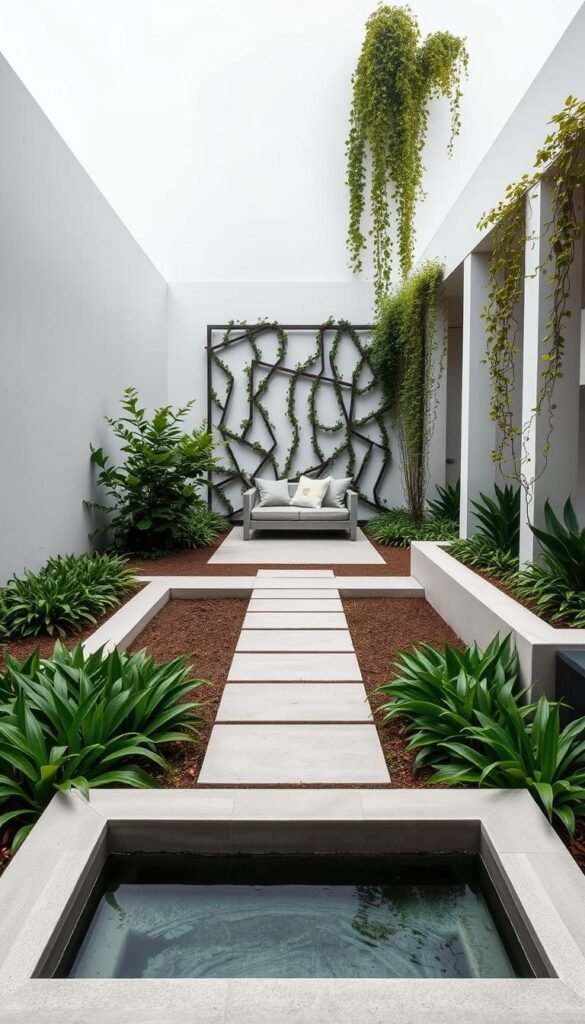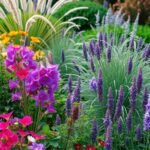Transforming your yard into a welcoming retreat starts with intentional planning. Today’s approach to shaping outdoor areas focuses on simplicity and practicality, blending natural elements with structured forms. Think open layouts, crisp edges, and plants chosen for both visual appeal and ease of care.
This method prioritizes harmony between your home and its surroundings. By using geometric shapes and purposeful empty areas, you create a sense of calm that feels both current and timeless. Materials like recycled stone or drought-tolerant grasses reduce upkeep while supporting eco-conscious values.
One standout feature is how these spaces merge indoor comforts with fresh-air freedom. Imagine seamless transitions from your living room to a patio designed for cozy evenings or weekend gatherings. Textured surfaces like smooth concrete paired with feathery grasses add depth without clutter.
Beyond looks, this style offers lasting benefits. Smart irrigation systems and native plants cut water use, saving you time and money. The result? A personal sanctuary that elevates your property’s value while reflecting your unique taste.
Discover the Essence of Contemporary Outdoor Spaces
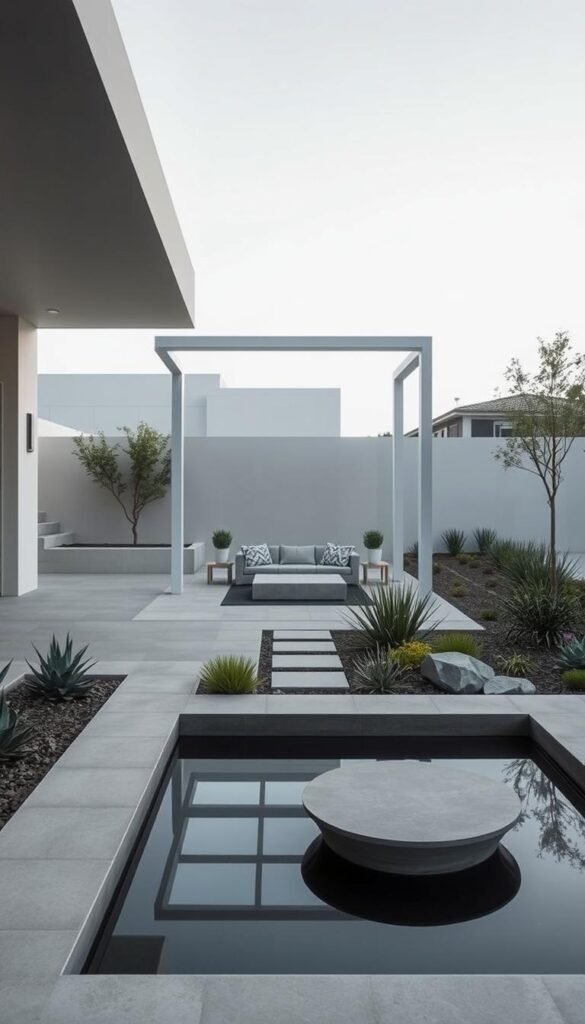
Today’s outdoor areas blend innovation with intentional simplicity. They’re not just about plants and pathways—they reflect how you live, entertain, and connect with nature. Think bold textures, curated contrasts, and spaces that work smarter, not harder.
Understanding Modern Trends
Current landscaping trends prioritize both beauty and brains. Smart irrigation systems sync with weather apps, while native plants thrive with minimal effort. Sleek materials like corten steel or polished concrete add structure without overwhelming your yard’s natural flow.
“Less clutter means more room to breathe,” says one landscape architect. This philosophy shines in features like recessed fire pits or vertical gardens that save space while making statements. For inspiration on blending form and function, explore our guide to elevating your space with purposeful touches.
The Role of Minimalism in Garden Design
True minimalism isn’t empty—it’s deliberate. Picture three sculptural olive trees framing a gravel courtyard instead of a crowded flowerbed. This approach lets each element shine while reducing upkeep.
Negative space acts like a frame, drawing eyes to focal points like a single stone basin or angular bench. Color palettes stay muted, allowing seasonal blooms or striking foliage to pop against neutral backdrops. The result? Calm meets character in every corner.
Why Embrace Minimalist Aesthetics in Your Garden
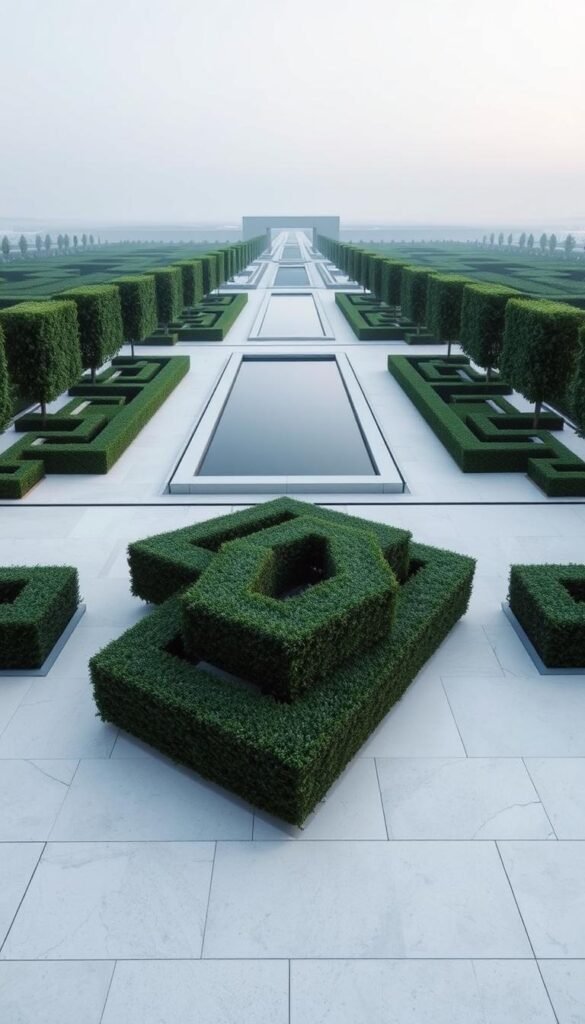
Your outdoor space becomes a calming retreat when you focus on intentional choices. By stripping away excess, you highlight what truly matters—structure, balance, and natural beauty. This approach transforms cluttered areas into curated environments that feel both peaceful and purposeful.
Emphasizing Clean Lines and Simplicity
Clean lines act as your yard’s backbone, guiding the eye while reducing visual noise. Picture gravel pathways bordered by crisp concrete edges or raised planters with sharp angles. These features create order, making upkeep simpler and highlighting key elements like sculptural plants or water features.
Geometric Shapes as Focal Points
Circles, squares, and triangles bring rhythm to your space. A circular stone patio draws people inward, while rectangular hedges frame views effortlessly. Symmetry in plant placement—like matching succulents flanking a doorway—adds harmony without fuss.
Want to see this in action? Explore minimalist landscape design ideas that use geometry to maximize small yards. Even simple choices, like repeating hexagonal pavers or triangular trellises, inject personality while keeping the look cohesive.
Integrating Sustainable Materials and Native Plants
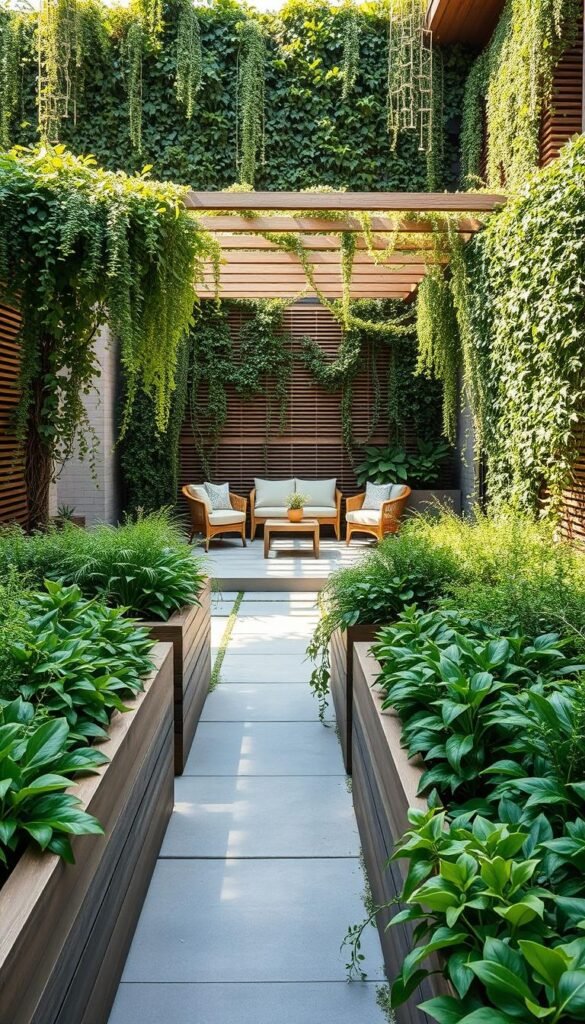
Smart outdoor spaces thrive when they work with nature, not against it. By pairing regionally adapted greenery with responsibly sourced hardscapes, you create ecosystems that flourish for decades. Let’s explore how to make choices that benefit both your yard and the planet.
Local Climate and Plant Selection
Your zip code holds the key to low-maintenance beauty. Native species thrive because they’re already adapted to your region’s rainfall and temperature patterns. Think purple coneflowers in Midwest prairies or agave in Southwest rock beds—these plants need 75% less water than imported varieties.
“Matching greenery to your local climate isn’t just practical—it supports bees and butterflies too,” notes Phoenix-based landscaper Lena Torres. For urban spaces, consider container gardening with drought-tolerant herbs like rosemary or thyme.
Benefits of Rainwater Harvesting and Eco-Friendly Materials
Collecting rainfall in barrels or underground cisterns cuts water bills by up to 50%. This chemical-free hydration keeps plants healthier while reducing stormwater runoff. Pair this approach with materials that tell a story:
| Material | Environmental Impact | Cost Efficiency |
|---|---|---|
| Recycled concrete | Diverts waste from landfills | 30% cheaper than new pavers |
| Reclaimed wood | Preserves mature trees | Lasts 2x longer than pressure-treated |
| Local stone | Reduces transport emissions | No shipping fees |
These choices create gardens that age gracefully while conserving resources. Over time, they become habitats—not just decorations—blending beauty with genuine sustainability.
Designing a Functional Modern Outdoor Living Space
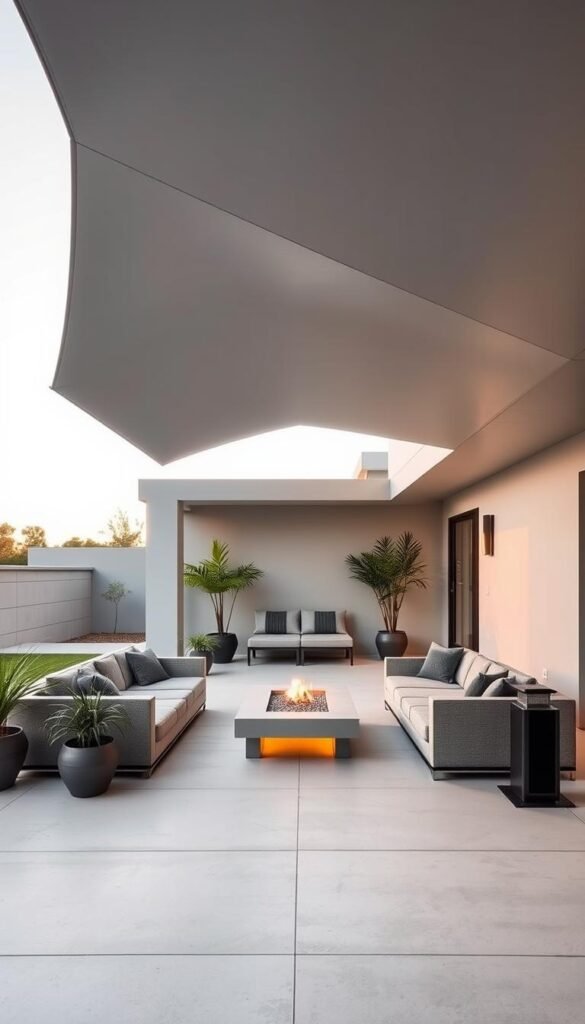
Your backyard becomes a natural living room when you prioritize flow and purpose. Start by mapping zones for dining, lounging, and cooking—each connected through smooth pathways. This functional approach turns unused corners into inviting spots for morning coffee or sunset gatherings.
Creating Comfortable Seating Areas
Arrange your furniture to mirror how people interact indoors. A U-shaped sectional around a fire table invites conversation, while bench seating along a planter wall saves space. Keep walkways at least 3 feet wide to prevent bottlenecks during parties.
Mix materials for visual interest: weatherproof wicker chairs paired with concrete side tables. Add throw pillows in fade-resistant fabrics for pops of color. For inspiration on arranging cozy nooks, explore unique ways to decorate your outdoor.
Balancing Style With Practicality
Choose pieces that withstand your local climate without sacrificing looks. Powder-coated aluminum dining sets resist rust, while teak benches age gracefully. Built-in storage under seats hides cushions during storms.
Lighting matters too. String lights above a dining area create ambiance, while recessed LEDs on steps boost safety. Remember: every element should serve a purpose, whether it’s a planter doubling as a privacy screen or a bar cart that wheels away when not needed.
Innovative Landscape Elements for a Contemporary Look
Elevate your outdoor experience by blending striking elements with atmospheric touches. These additions transform ordinary yards into dynamic spaces that engage both sight and sound.
Water Features That Captivate
Moving water brings life to your landscape. Think narrow sheet waterfalls cascading down slate walls or geometric fountains with recycled-glass basins. These features mask street noise while attracting birds—nature’s own ambiance enhancers.
“Water isn’t just decorative—it’s therapeutic,” notes landscape designer Mara Voss. Pair shallow reflecting pools with drought-resistant grasses for texture contrast. For evening magic, combine water displays with fairy lights to double the visual impact.
Lighting That Transforms Spaces
Strategic lighting turns night into a design asset. Use these three layers for depth:
| Type | Purpose | Best For |
|---|---|---|
| Path lights | Safety & guidance | Low-voltage LEDs along walkways |
| Uplights | Drama | Highlighting trees or sculptures |
| String lights | Ambiance | Over dining areas or pergolas |
Smart systems let you adjust brightness via phone apps. Warm white tones (2700K-3000K) create inviting ambiance, while colored options suit holiday themes. Solar-powered options cut energy use by 80% compared to traditional bulbs.
Showcasing Bold Colors and Modern Outdoor Furniture
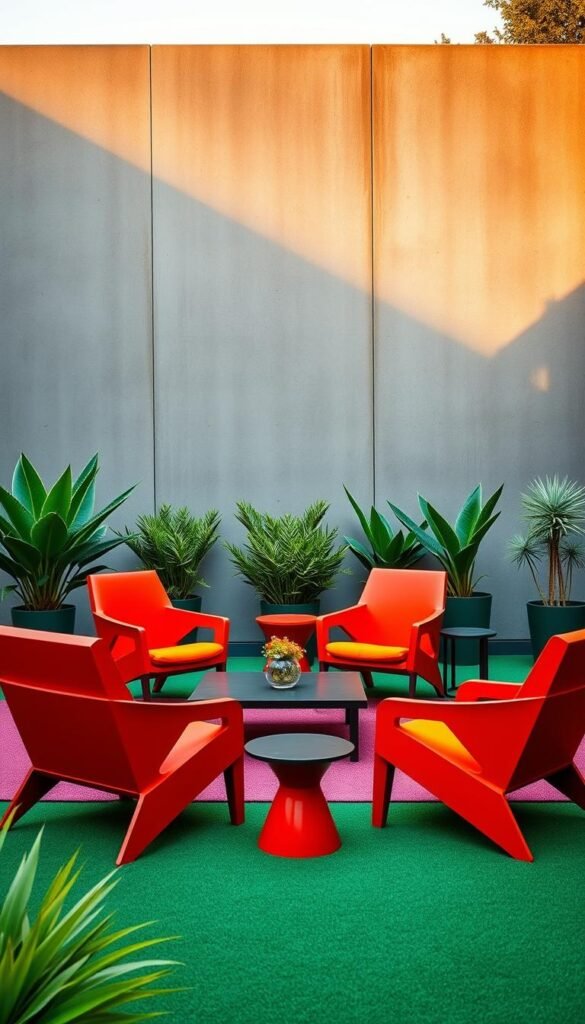
Your outdoor area becomes a canvas when you play with vibrant hues and sculptural forms. Strategic color choices breathe life into neutral backdrops, while furniture with crisp profiles adds both function and artistry. This approach turns ordinary corners into destinations that spark joy and conversation.
Choosing Statement Pieces for Your Garden
Start by selecting one or two eye-catching items as anchors. A deep blue sectional or sunshine-yellow dining set instantly defines your style. Pair these with simpler pieces in neutral tones to let the bold shades shine without overwhelming the space.
Consider material durability alongside aesthetics. Powder-coated aluminum resists fading in sun-drenched regions, while all-weather wicker offers texture without high maintenance. “Color isn’t just decorative—it’s how your outdoor space expresses personality,” notes designer Eli Martinez.
Coordinate accents with existing elements for cohesion. Match throw pillows to blooming flowers or paint a side table to echo your home’s trim. This creates rhythm between your garden and living areas, making both feel intentionally connected.
Remember: balance prevents visual chaos. Use the 60-30-10 rule—60% neutral tones, 30% secondary colors, and 10% bold pops. A crimson umbrella over a gray patio set or turquoise planters flanking a doorway achieves this harmony effortlessly.
Essential Tips for Low-Maintenance Garden Design
Creating an outdoor space that thrives with minimal effort starts with smart choices. Focus on solutions that save time and resources while keeping your garden vibrant. The secret? Let nature do the heavy lifting.
Selecting Drought-Resistant and Native Varieties
Choose plants that match your region’s rainfall and soil. Native species like purple coneflowers or switchgrass need 60% less care than non-native options. Their deep roots handle dry spells naturally, cutting watering trips.
| Plant Type | Water Needs | Maintenance Level |
|---|---|---|
| Coneflowers | Low | Once/month |
| Sagebrush | Very Low | Twice/year |
| Switchgrass | Moderate | Seasonal trim |
Pair these with gravel paths or stone borders to reduce areas needing regular maintenance. For eco-friendly layouts, explore permaculture principles that work with your local ecosystem.
Prep soil with compost to boost moisture retention. Mulch beds suppress weeds and insulate roots. Smart irrigation systems cut water use by 40%, letting you enjoy weekends instead of yard work.
Modern Garden Design: Sleek Lines, Minimalist Aesthetics, and Innovative Layouts
Crafting an outdoor sanctuary requires balancing form and function with precision. Today’s most striking spaces combine bold geometry with purposeful simplicity, where every detail serves both beauty and practicality.
Key Features and Signature Elements
Geometric patterns anchor contemporary spaces, creating rhythm through repetition. Picture hexagonal stepping stones leading to a circular seating area or rectangular planters echoing your home’s architecture. These shapes guide movement while maintaining visual calm.
Material contrasts add depth without clutter. Pair smooth concrete with feathery grasses or rough-hewn stone with glossy ceramic pots. “Texture is the secret weapon,” says landscape architect Nina Choi. “It replaces ornamentation in minimalist spaces.”
| Hardscape | Softscape | Function |
|---|---|---|
| Concrete pavers | Ornamental grasses | Defines pathways |
| Corten steel screens | Dwarf Japanese maple | Adds privacy & color |
| Recycled glass mulch | Lavender hedges | Reduces water use |
Expert Advice for a Cohesive Look
Connect zones using repeated materials. A stone patio might extend as stepping stones through planting beds, then reappear as a fireplace surround. This creates flow while keeping the layout uncluttered.
Limit your plant palette to three main varieties for harmony. Tall grasses add vertical lines, groundcovers fill gaps, and sculptural succulents serve as focal points. For seasonal interest, layer bulbs like alliums that bloom sequentially.
When blending styles, follow the 80/20 rule: 80% clean lines, 20% personality. A curved bench or vintage planter adds character without disrupting the minimalist base. Proper spacing between plants ensures each specimen shines while reducing maintenance.
Personalizing Your Landscape With Artful Touches
Your outdoor space becomes an extension of your personality when you blend practicality with creative flair. Thoughtful personalization transforms standard layouts into living expressions of your tastes, merging beauty with purpose in every corner.
Mixing Edibles With Ornamentals
Why choose between pretty and practical? Combine flowering kale with lavender borders or tuck basil between hostas for fragrant greenery. This approach maximizes your landscape’s potential, offering fresh herbs and vibrant colors in one stroke.
Container gardens shine here. Use sleek planters for dwarf citrus trees or vertical towers for strawberries—they add height while saving space. Move pots to optimize sun exposure or create temporary privacy screens during gatherings.
Stick to a cohesive color scheme to maintain sophistication. Purple sage pairs elegantly with silver dusty miller, while cherry tomatoes pop against dark-leafed coleus. Artful arrangements turn functional plants into design stars, proving edibles belong in polished gardens.

